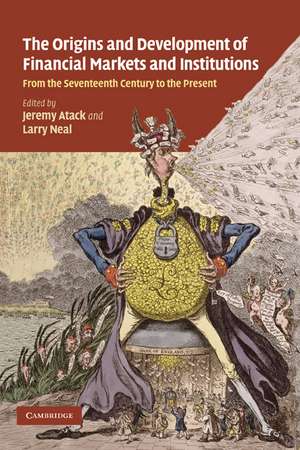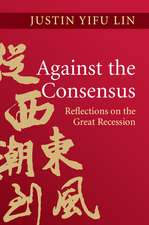The Origins and Development of Financial Markets and Institutions: From the Seventeenth Century to the Present
Editat de Jeremy Atack, Larry Nealen Limba Engleză Paperback – 13 apr 2011
| Toate formatele și edițiile | Preț | Express |
|---|---|---|
| Paperback (1) | 443.46 lei 6-8 săpt. | |
| Cambridge University Press – 13 apr 2011 | 443.46 lei 6-8 săpt. | |
| Hardback (1) | 608.30 lei 6-8 săpt. | |
| Cambridge University Press – 15 mar 2009 | 608.30 lei 6-8 săpt. |
Preț: 443.46 lei
Nou
Puncte Express: 665
Preț estimativ în valută:
84.85€ • 88.60$ • 70.23£
84.85€ • 88.60$ • 70.23£
Carte tipărită la comandă
Livrare economică 04-18 aprilie
Preluare comenzi: 021 569.72.76
Specificații
ISBN-13: 9780521154765
ISBN-10: 0521154766
Pagini: 496
Ilustrații: black & white illustrations
Dimensiuni: 152 x 229 x 28 mm
Greutate: 0.72 kg
Editura: Cambridge University Press
Colecția Cambridge University Press
Locul publicării:Cambridge, United Kingdom
ISBN-10: 0521154766
Pagini: 496
Ilustrații: black & white illustrations
Dimensiuni: 152 x 229 x 28 mm
Greutate: 0.72 kg
Editura: Cambridge University Press
Colecția Cambridge University Press
Locul publicării:Cambridge, United Kingdom
Cuprins
List of figures; List of tables; List of contributors; 1. Financial innovations and crises: the view backwards from Northern Rock Jeremy Atack; 2. An economic explanation of the early Bank of Amsterdam, debasement, bills of exchange and the emergence of the first Central Bank Stephen Quinn and William Roberds; 3. With a view to hold: the emergence of institutional investors on the Amsterdam securities market during the 17th and 18th centuries Oscar Gelderblom and Joost Jonker; 4. Was John Law's system a bubble? The Mississippi Bubble revisited François R. Velde; 5. Sir George Caswall vs. the Duke of Portland: financial contracts and litigation in the wake of the South Sea Bubble Gary S. Shea; 6. The Bell Jar: commercial interest rates between two revolutions, 1688–1789 Marc Flandreau, Christophe Galimard, Clemens Jobst and Pilar Nogues Marco; 7. Comparing the UK and US financial systems, 1790–1830 Richard Sylla; 8. Natural experiments in financial reform in the nineteenth century, the Davis and Gallman analysis Larry Neal; 9. Regulatory changes and the development of the US banking market, 1870–1914: a study of profit rates and risk in national banks Richard J. Sullivan; 10. Anticipating the stock market crash of 1929: the view from the floor of the stock exchange Eugene N. White; 11. The development of 'non-traditional' open market operations: lessons from FDR's Silver Purchase Program Richard C. K. Burdekin and Marc D. Weidenmier; 12. The interwar shocks to US-Cuban trade relations: a view through sugar company stock price data Alan Dye and Richard Sicotte; 13. Central Bank reaction functions during the inter-war Gold Standard: a view from the periphery Kirsten Wandschneider; 14. Monetary policy and equity price booms: historical cross-country evidence Michael Bordo and David Wheelock; 15. Lessons from history for the twenty-first century Larry Neal; Index.
Recenzii
Review of the hardback: 'Atack and Neal bring together a brilliant, provocative and authoritative set of essays on financial history. The essays share the desire to link social, political, and economy history with finance, to place financial development within the story line that connects financial changes to the development of commerce, industry, and politics. The coverage is broad in space and time, covering all aspects of finance - money, banking, central banking, securities markets, and financial crises - in many countries and over four centuries of change. The authors are the leading authorities in their field. Although the articles are carefully argued and rich in quantitative detail, they are exceptionally lively because they combine the discipline of economic analysis with a broader historical narrative that brings to life the personal histories of financiers as part of the broader arc of European and American financial development. The book is more than a collection of great studies of the past; it is also a tool to teach historians how to think about finance, and to teach financiers how to think about history.' Charles Calomiris, Columbia University Graduate School of Business
Review of the hardback: 'In this splendid collection, distinguished financial historians from many countries discuss the most important features of financial markets and institutions, covering a great span of time from the seventeenth century to the recent past. Larry Neal himself has written a masterly summary of the main findings that brings out lessons learned in the past and those that were missed. This book should be put in the hands of regulators and central bankers everywhere. They would benefit from reading more financial history of this kind.' Forrest Capie, Official Historian, Bank of England, and Cass Business School
Review of the hardback: 'The credit crisis in the United States has created new doubts, not least in academic circles, about the advantages of sophisticated financial markets. This collection by Atack and Neal is therefore all the more timely as a reminder that financial development, done right, solves more problems than it creates. In its use of history it is also a reminder of the need to avoid fighting the last war. Financial institutions and markets are in a continuous state of flux and the consequences of regulatory responses are not always as expected. There are lessons here, in other words, not just for historians but for policymakers and investors.' Barry Eichengreen, University of California, Berkeley
Review of the hardback: 'In this splendid collection, distinguished financial historians from many countries discuss the most important features of financial markets and institutions, covering a great span of time from the seventeenth century to the recent past. Larry Neal himself has written a masterly summary of the main findings that brings out lessons learned in the past and those that were missed. This book should be put in the hands of regulators and central bankers everywhere. They would benefit from reading more financial history of this kind.' Forrest Capie, Official Historian, Bank of England, and Cass Business School
Review of the hardback: 'The credit crisis in the United States has created new doubts, not least in academic circles, about the advantages of sophisticated financial markets. This collection by Atack and Neal is therefore all the more timely as a reminder that financial development, done right, solves more problems than it creates. In its use of history it is also a reminder of the need to avoid fighting the last war. Financial institutions and markets are in a continuous state of flux and the consequences of regulatory responses are not always as expected. There are lessons here, in other words, not just for historians but for policymakers and investors.' Barry Eichengreen, University of California, Berkeley
Descriere
Leading historians examine how financial innovations have challenged established institutional arrangements from the seventeenth century to the present.















